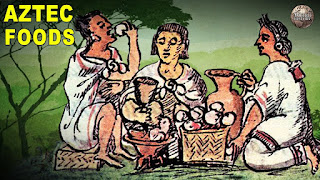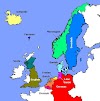Historical Food
What Aztecs Were Eating Before European Contact
Throughout the 14th and 15th centuries,
The area that is now Mexico was home to a thriving civilization
Known as the Aztecs.
Before being overthrown by the Spanish crown
Through the conqueror, Hernán Cortés, in 1521,
This complex Mesoamerican culture
Developed a unique cuisine that is still popular today.
So today, we are going to take a look at what the Aztecs were.
Eat before European contact
1.CHOCOLATE
If you like chocolate you owe yourself a big thank you
To the Aztecs, who made several significant contributions
To its development.
For the Aztecs, what they called xocoatl,
It was considered a food of the gods, which to be fair,
It is what most people still consider today.
Now just to be clear, xocoatl like the Aztecs do,
It is very different from the chocolate of modern times.
For one thing, it wasn't sweet.
It also did not form into bars.
In fact, it didn't actually transform into anything.
The Aztecs actually made a drink from the cocoa bean
Instead of transforming it into solid treatment
Used to do now.
The effects of that drink were detailed in the Florentine
Codex, written work of the 16th century
By Bernardino de Sahagún, a Spanish monk who lives
In Mesoamerica.
According to him, drinking too much cocoa
I would get drunk, I would dizzy, I would confuse, I would get sick,
In his words, upset.
In other words, a typical Friday night outing.
Yes!
While there has been much speculation
On the subject over the years, historians
I'm not sure what exactly makes the drink intoxicating.
What is known, however, is that the cacao tree had
Religious significance for the Aztecs,
And the drink was used in various rituals.
2.TORTILLAS
The Aztec diet incorporated many foods,
But it revolved mainly around consumption
Corn, or what is known today as corn.
A well-known example of how corn
Joined the Aztec diet
It is in the now world famous Omelette.
The tortillas they made back then, while various
In size, shape and function as they are now.
And everyone in the Aztec empire, regardless
Of social class, consumed them.
The flour that the Aztecs used to make tortillas
Came from corn that went through a process called
Nixtamalization.
The grains were boiled in water,
And ashes of juniper wood.
They were then soaked overnight until the outside hard
Every grain had come off.
The remaining corn was then ground into flour.
The Florentine Codex is quite detailed
On the many tortilla options available to food buyers
In Tenochtitlan.
According to the Codex, the food vendor
It sells folded tortillas, thick tortillas, and thick tortillas.
He sells Omelettes with turkey eggs, Omelettes
Made with honey, pressed, shaped [INAUDIBLE]
Tortillas, simple tortillas, assorted, stewed,
Sweet tortillas, amaranth seed tortillas, pumpkin tortillas,
Green corn tortillas, brick tortillas, tuna cactus
Tortillas, old crumbled broken tortillas, cold tortillas,
Tostadas, dry tortillas, and stinky tortillas.
It is a menu that sounds appetizing,
Except maybe the stinky tortillas.
It depends on what they stick to.
It makes the difference.
3.AMARANTH TAMALES
The amaranth plant had a religious significance.
For the Aztecs, and their seeds and leaves
They were used in various types of cuisine.
Amaranth seeds can be cooked, combined
With sweeteners like agave to make dough,
Or added to other dishes.
For the lords and upper classes, it was
Cooked in Tamallis, especially on holidays.
During these celebrations, it was even possible that commoners
To get your hands on these specialties.
The Florentine Codex actually describes the preparation
Of some varieties, such as Tamallis made from corn flour
With ground amaranth seeds and added cherries.
And tamallis stuffed with amaranth.
Does anyone else have the feeling?
That Bernardino Sahagún longed for Mexican food?
4.PEPIAN
Even in an empire where food was plentiful,
The rich still had access to a little more
Than everyone else.
The upper classes of the Aztec empire
I enjoyed tasty sauces, stews, and casseroles.
The Florentine Codex describes a particular casserole
Devoured by lords like a kind of casserole
Of birds made their way with red chili
And with tomatoes and ground pumpkin seeds, a dish that
Now it is called Pepian.
Also known as "Pepian", this dish
Today it is a Guatemalan stew par excellence.
While it has evolved over the centuries,
The dish actually still has many of its original features.
In its modern form, it is normally served with a single meat.
Although there are also recipes
For a full version of three meats.
It always contains vegetables and fruits,
Such as pear, pumpkin, carrot, potato, and corn on the cob.
And the conventional wisdom is that
Should be thick and rich with lots of roasted spices
Mixed together.
5.AHUACA-MULLI
Evidence shows that avocado trees
They were cultivated in the Americas as early as 750 BC. C.
And Ahuaca-Mulli or avocado sauce,
It is essentially a very early version of guacamole.
In fact, it was the Spanish who converted the word ahuacatl
In the word avocado, which eventually
Evolved to avocado.
Meanwhile, the term ahuaca-mulli slowly transformed
In the word guacamole.
Anyway, the pre-Columbian Aztecs
I have eaten these mashed avocados with tomatoes
And some coriander leaves.
The Spanish picked up this recipe,
Brought it back to Europe and I added some twists to it
Own, which is how we get
The modern version of the dish.
That being said, it's still not that different from what
The Aztecs enjoyed it.
One historian even wistfully suggested
That wrapped in a freshly made corn tortilla
Or even enjoyed on a tortilla chip,
Ahuaca-mulli could evoke very distant
The taste of Tenochtitlan.
6.LAKE-DWELLING AMPHIBIANS AND BUGS
The land around Tenochtitlan was swampy and muddy.
And the Aztecs made the most of agriculture
Of the situation.
They built artificial agricultural islands
Called chinampas, made by accumulating mud
From the bottom of lakes and swamps.
Channels were then placed around these chinampas
So that they are accessible and that the water flows around them.
But the Aztecs also used the surrounding lakes.
To add to your live food sources.
They fed on frogs, water bugs, and lake shrimp.
But they also didn't hesitate to chew eggs
And larvae of insects and amphibians.
In fact, one of their delicacies was the axolotl,
A larval salamander.
According to the Florentine Codex,
These creatures that inhabit the lake could be
Prepared in various ways.
Frog tamales, frog with corn kernels,
Axolotl with corn kernels, axolotl tamallis,
Tadpoles with corn kernels, and that's just to name a few.
7.TURKEYS
They were actually the pre-Aztec peoples
Who lived in the area that is now Mexico between 800 BC. C.
And 200 a. C. Who were the first to domesticate turkeys.
These early users ate the meat and eggs of the birds
To get protein, and even use their feathers
For decorative purposes.
Their Mesoamerican descendants continue the tradition.
And the turkeys that we still eat today
They owe their existence directly to those practices.
These domesticated turkeys were sources
Of food with his wild brothers,
Which tended to be smaller and considerably less meaty.
Some of these alternative meats that the Aztecs also ate
Came from deer, peccaries, rabbits, rabbits, mice,
Armadillos, snakes, gophers, possums and iguanas.
These animals, once captured, were fattened in captivity
Until they were eaten.
8.TECUITLATL
Tecuitlatl, which means stone manure
In the Aztec language, Nahuatl, it is a little more palatable
Than its name might imply.
It is actually an edible seaweed or seaweed,
That the Aztecs collected with tools,
Like nets and shovels.
Once collected, it would be dried in the sun.
After it was dry, the Tecuitlatls
It would be formed into cakes, it would dry again and then
Used to make tortillas.
According to Díaz del Castillo, one of the first Spanish
To visit Tenochtitlán, there were fishmongers and other
Who sold bread, who made
Of some kind of slime, which they collected
Of the great lake, which thicken and make bread
Of her, which tastes like cheese.
A later writer also compared its taste.
To cheese, except they found it less pleasant,
And with a certain muddy flavor.
9.HUITLACHOCHE
Known as the corn mushroom, corn char, or Mexican truffles,
Huitlachoche is a corn fungus, which today,
It is considered a gourmet meal.
In Nahuatl, the word Huitlachoche
It results in a dormant outgrowth.
This is because the fungus affects
The growth of corn kernels, in essence,
Making them fall asleep.
This sounds like a bad thing, but the Aztecs finally
He saw the effect as a blessing in disguise.
Because they still have sustenance
From the fungus that was ruining his beloved corn.
That's one way to look at mushrooms with a half glass full.
When it comes to preparing Huitlachoche in the kitchen,
Many authorities agree that the young white fungus
It tastes good raw, while aged black mushroom is better cooked.
10.OCTLI
Octli, also known as pulque, was a fermented drink.
Derived from the sweet sap of the agave plant.
The Aztecs referred to this plant as maguey,
And is affiliated with a pulque goddess, Mayahuel.
The drink was consumed for various rituals,
Often intricate vessels.
It would be consumed by priests and sacrificial victims.
Before ceremonies, and was used by the nobility
To celebrate victories.
The Aztecs also had several established rules and guidelines.
For consumption and creation.
For example, when it came to commoners, only
The elderly and pregnant women were able to participate.
And for those who made the drink,
They would have to abstain from sex,
Since it was believed that intercourse spoiled the process.
However, despite its obvious cultural importance
For the Aztecs, the drink is actually
It is believed to predate their culture.
11.PINOLI
Aztec society was extremely stratified,
And while the upper echelons and royalty enjoyed rich and meaty
Food, the lower ranks were forced
Adhere to predominantly vegetarian diets.
An example of this is pinoli, which is
The Nahuatl word for corn flour.
Pinoli was a kind of testament
To the itinerant nature of the life of the poor or contracted Aztecs.
This simple meal of ground and roasted corn held up well,
And travelers or warriors could take it to access
To a quick and filling dish.
While lacking in flavor, pinoli could
Mixed with water and other ingredients, such as cocoa,
To make it more enjoyable.
This type of instant food, called [INAUDIBLE] ,,
They were popular with lower-class Aztecs.
Think of them as the ancient Mesoamerican equivalent
Of television dinners.
So what do you think?
Which of these Aztec food sounds the most delicious to you?
Let us know in the comments below.
american food history,history of british food,food and history,historic food,german diet history,history and origins of foods,historical food,onion price history,history of english food
historical food recipes,history of food pdf,history of food timeline,brief history of food,when was food invented,when was food discovered,historical recipes of different cultures,the history of food documentary






















0 Comments